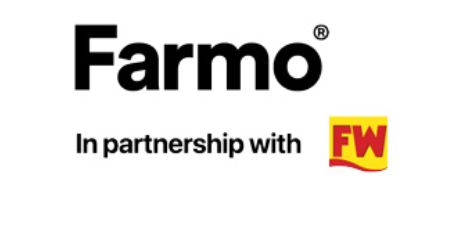Driver’s view: Contractor rates pre-production Claas Jaguar 1200
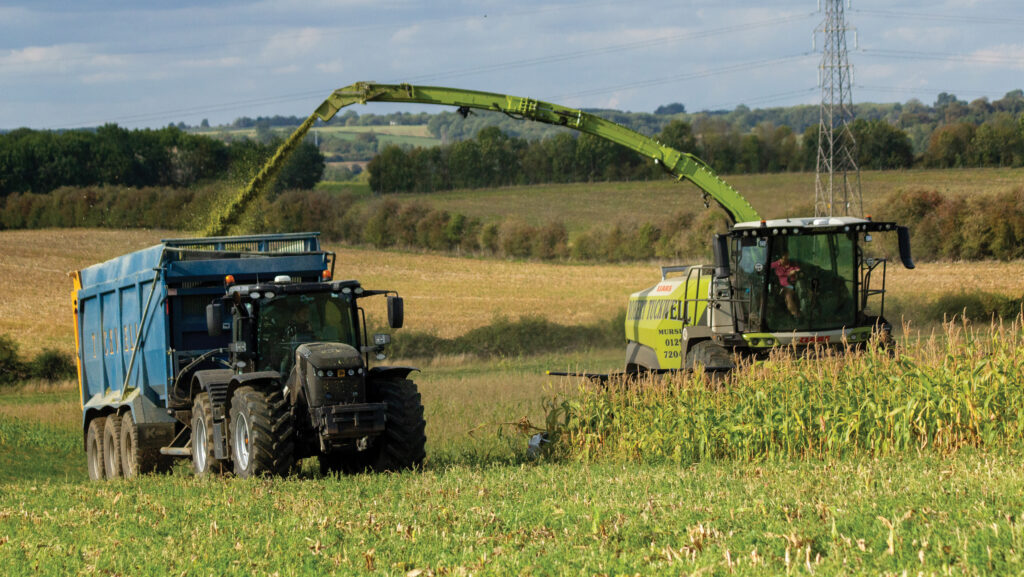 © Adam Clarke
© Adam Clarke Demand for more chopping capacity has driven Claas to join John Deere and Krone in the 1,000hp forage harvester division, as it looks to deliver the throughput expected by mega dairies and large-scale contractors.
The flagship 1,220hp Jaguar 1200 – reckoned to be good for a maximum of 500t/hour – heads the 1000-series line-up, backed up by the 1,020hp 1100, 925hp 1090 and 850hp 1080.
The smaller pair overlap, in horsepower terms, with the top two 900-series models.
See also: Driver’s view: James Ireland’s Pottinger Jumbo 5340
One large-scale outfit that’s had an early insight into the the merits of these latest Jags is Robert Tuckwell Contracting, which offers foraging services from its base in Mursley, outside Milton Keynes.
Daniel Tuckwell, who runs the business in partnership with his father, Robert, took the chance to invest in the new 1200 and assist in its final fine-tuning ahead of the official launch in August.
In the past, the firm had run two Jaguars but struggled to maximise output of both throughout the season, so more recently it has operated with a lone 980.
However, with a significant increase in its anaerobic digestion (AD) maize area this year, the arrival of the new 1200 could not have come at a better time.
Its livery was divested of a model number to avoid revealing its identity, and the machine inconspicuously made its way through some 2,200ha of grass, 1,000ha of wholecrop, and more than 1,600ha of maize.
Efficiency gains
Daniel says improvements in efficiency have been the biggest win, with the extra horsepower allowing it to eat acres faster and use less fuel per tonne than the 980.
Although spot rates weren’t as high as expected due to the dry season and thin crops, the 1200 still chomped through 300-400t/hour.
“Last year, we were at 0.95 litres/t and this year we’re between 0.75 and 0.8 litres/t.
“We were happy with the 980 but we jumped at the chance to go to the next level.”
The increased output of the 1200 hasn’t required additional investment in the team’s carting capacity, but there has been a change on the clamp which prospective buyers may need to factor in.
“Rather than two smaller loaders, we’ve had a new 457 Agri this time – one of JCB’s largest shovels – and its only job is pushing up.
“It doesn’t have time to do the compacting, so we’ve put a full-time compactor tractor alongside it,” he explains.
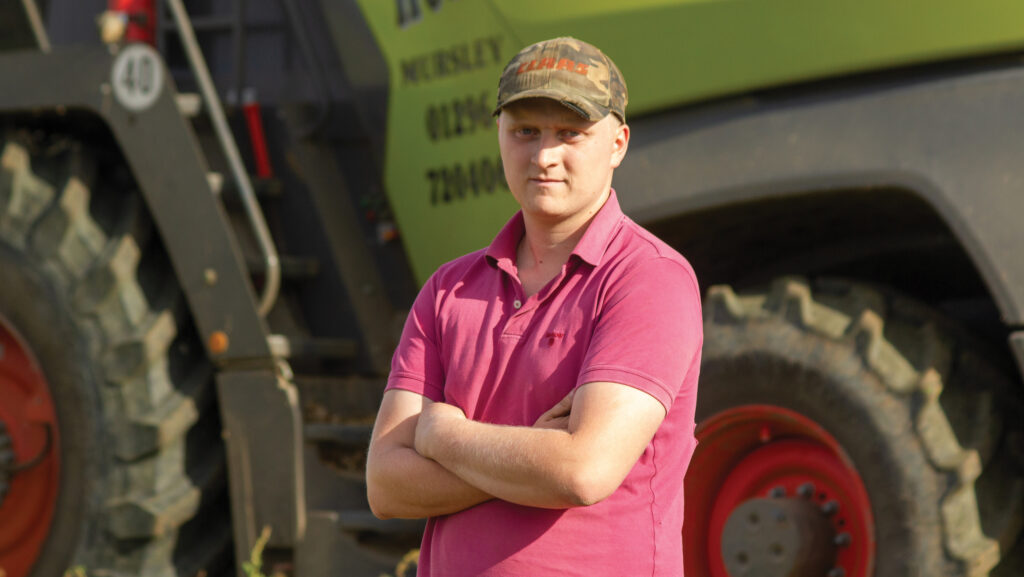
George Singer © Adam Clarke
So, what’s new on the 1000-series?
Here, we summarise the new or updated features and Tuckwell’s forager operator, George Singer, offers his thoughts on each after a full season at the wheel.
Driveline
- 24-litre V12 MAN (same as 900-series) with new turbo and remapped software
- Crop processor and feed rollers powered independently
- Ground drive, rollers and attachments run via hydraulic motors from pump transfer case
- Independent adjustment of pick-up, intake auger, knives, discs and feed drums
- On-road mode decouples chopping unit and intake, saving fuel
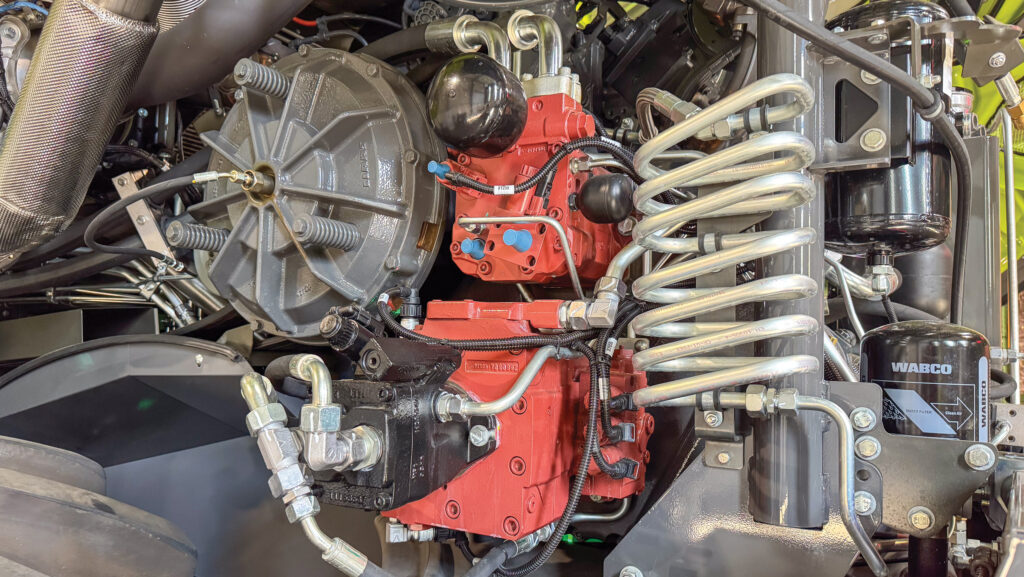
Hydraulic pump transfer case © Adam Clarke
George’s verdict: “The independent control of the pick-up and intake auger has made a difference in grass, especially in damp, late-season crops.
“This has enabled me to run the pick-up tines much faster without adjusting the auger, which helps lift the crop and not leave any behind.
“I’ve not seen a significant advantage from the independent adjustment in maize yet.
“But we haven’t had a great year – there have been a lot of shorter crops – and it might come into its own in a different season.”
Feeder unit
- Redesigned feeder with 20% wider processing unit
- Heavier-duty components and 80deg opening for easier access
- Four pre-compression rollers now fully hydraulic with auto adjustment to crop conditions
- Rollers lift into maintenance position for cleaning and servicing
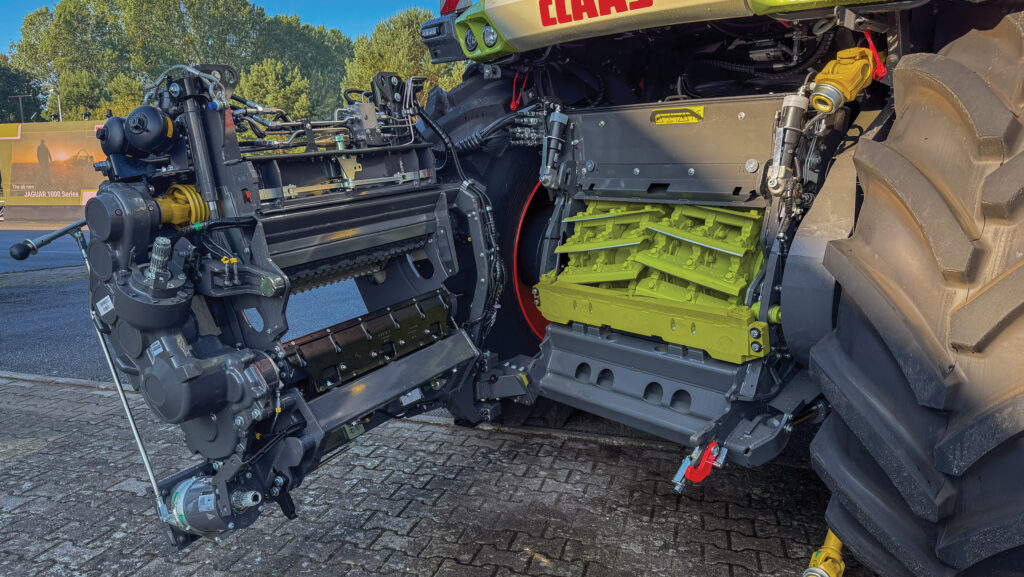
Front-end access © Adam Clarke
George’s verdict: “The whole feeder unit is so much easier to clean.
“On the old machine, the feed rollers dropped when switched off, so needed a block of wood underneath.
“With this one I can touch a button on the in-cab screen to lift the rollers out of the way and lock them in place.
“I can then safely get in there to clean all the difficult spots, including underneath gearboxes.
“The process is twice as quick and I’ve been more inclined to keep things clean because it’s so much easier.
“There’s also no need to drop the header off and open up the front to inspect the knives.
“If I’m waiting for a trailer, I can part the feed rollers and have clear sight of whether they need sharpening or not, which is a timesaver.”
Chopping cylinder
- Wider 910mm V-Flex cylinder
- Knives at 10deg angle to improve chop quality and lower noise
- Water-assisted sharpening lowers fire risk in dry conditions
- Claas sharpening: six passes in 72sec
George’s verdict: “The sharpening system is one area where there hasn’t been significant improvement on the 1000-series.
“It’s effectively the same as before and, with a bigger set of knives to sharpen, I’ve found the process slightly slower.
“The water-assist feature has been good, particularly in this year’s dry conditions.
“Before, I’d be a bit wary of when and where I was sharpening and perhaps give the area a blow out before I started.
“Knowing the sharpening area is damp just gives some peace of mind against fires.”
Corn cracker
- Enlarged MCC XL (752mm wide, 310mm rollers)
- Available in sawtooth (40% speed difference) or shredlage (50%)
- Easier removal/installation due to slimmer fan and redesigned panels
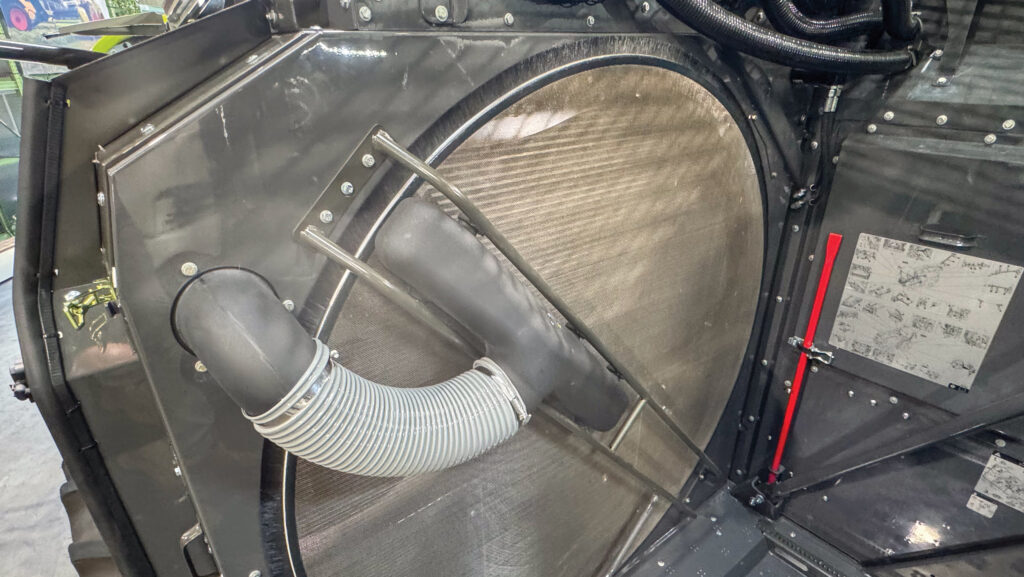
Slimline radiator screen © Adam Clarke
George’s verdict: “The cracker in the 980 was pretty good in maize, but in wholecrop it would sometimes struggle to break the smallest grains.
“With the far larger surface area of the XL, we’ve had no issues this year.
“This, and the greater speed differential between the rollers, also means the gap can be set a bit wider without affecting performance.
“Getting the corn cracker in and out used to be a bit of a weakness.
“But they’ve now slimmed down the screen on the cooling system so much it feels as though there’s twice the space.”
Accelerator and chute
- Accelerator repositioned deeper for higher crop velocity, especially in grass
- Adjustable clearance 10-60mm (versus 10-50mm on 900-series)
- Wider, higher, longer chute
- Modular chute extensions
- Autofill with automatic trailer switching
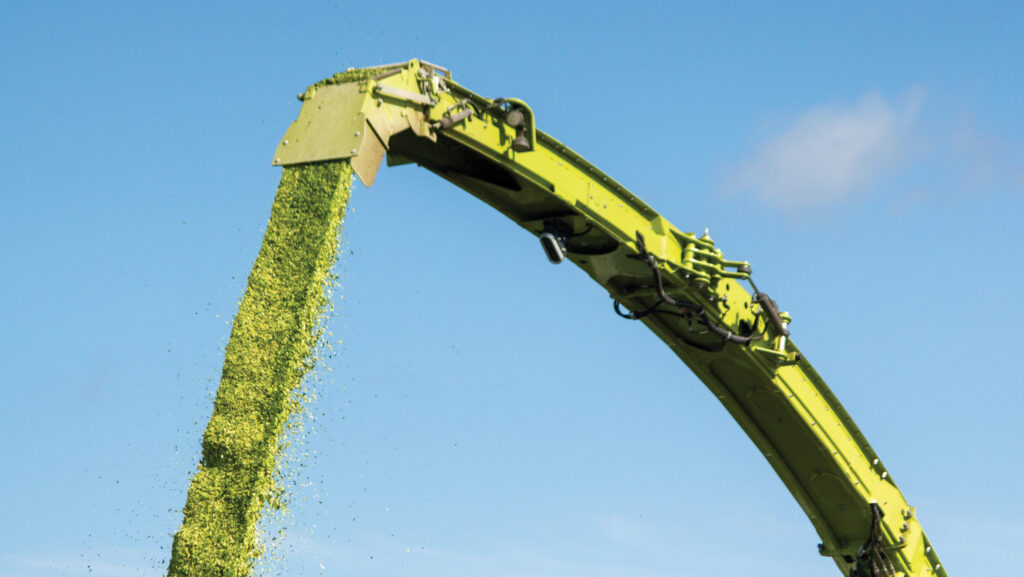
The Jaguar 1200’s chute © Adam Clarke
George’s verdict: “With more power and a bigger chopping cylinder, it feels like that’s doing much more to get the crop out of the chute.
“It’s less reliant on the accelerator and the blow you get is insane.
“Running the accelerator gap wider, up to 60mm, has also reduced engine load and fuel consumption when in decent wholecrop or maize.
“It now takes about 20mins rather than a couple of hours to change the chute extension, with six bolts and quick couplers.
“The built-in lifting rings are also perfectly balanced, so extensions are easier to lift into place.
“We have the ‘auto fill’ system, as we did on the 980, and it works well loading trailers to 75% before topping up manually.
“So far, I’ve not had much success getting the new trailer switching feature to work.
“We have mostly Ktwo trailers, but they aren’t all the same size.
“If they were identical then perhaps it would be simpler than with mixed fleets.”
Grass pick-up
- New 4.5m Pickup 4500 (joins 3000 and 3800)
- Independent hydraulic drive for pick-up and auger (automatic with Cemos)
- Pto shafts and gearboxes replace chains
- Five-row reel with oil-lubricated cam tracks
- Quick-release plastic strippers
- Active Contour and swingarm-mounted pick-up for ground following
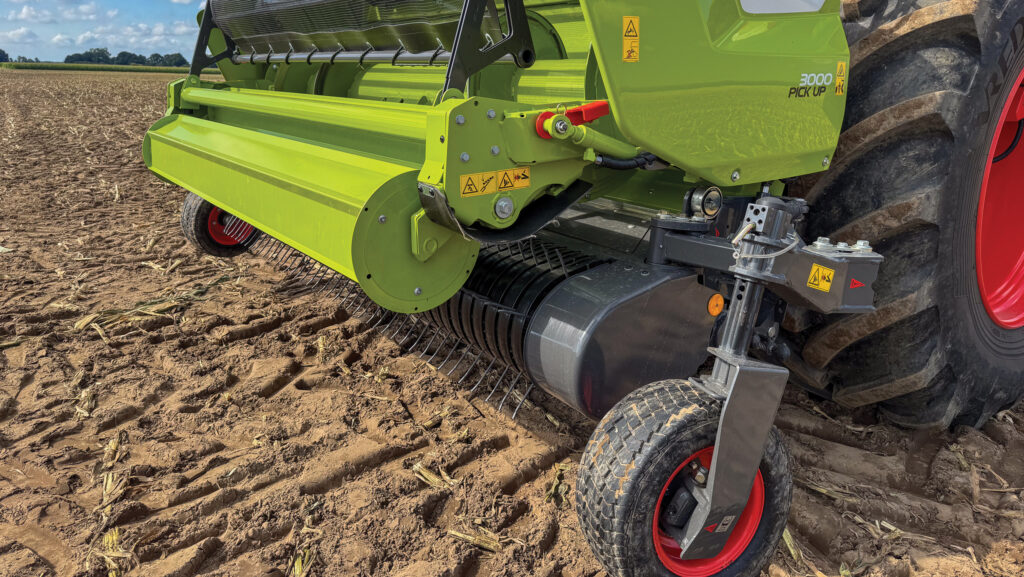
Grass pick-up © Adam Clarke
George’s verdict: “The older generation header on our 980 was a bit of a limiting factor, with chain drives, slip clutches, and poorly matched speeds when chopping short.
“We are running the new generation Pickup 3000 this year, and its hydraulically driven gearboxes have infinitely variable speed, which I’ve set on auto to match everything to forward speed.
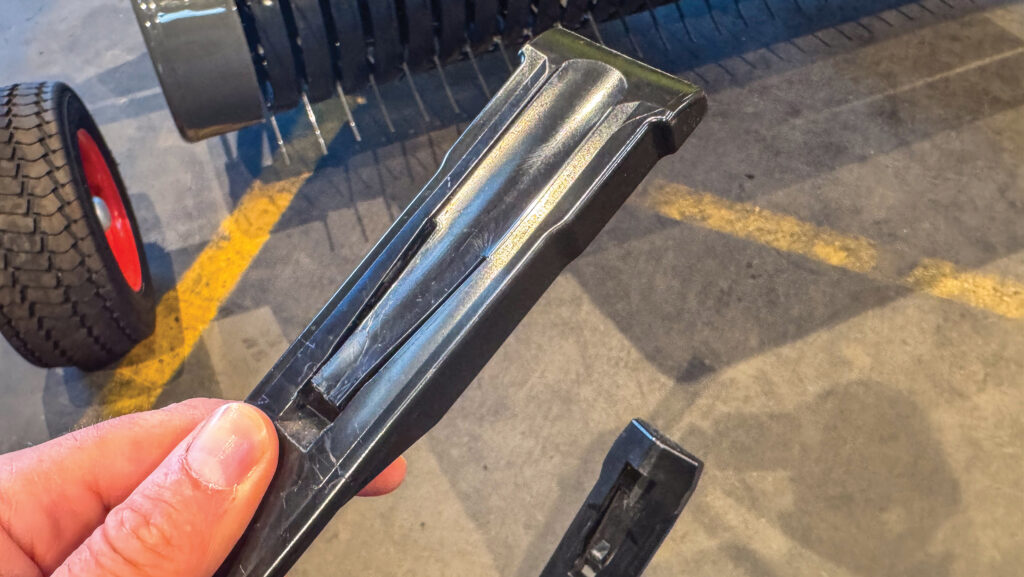
Plastic strippers © Adam Clarke
“I like the new quick-release plastic strippers as well.
“The old steel ones were fiddly to replace, as I had to get the bolt holes lined up and bend them into place.
“Now, it takes a screwdriver to pop the stripper off, change the tine and refit it.”
Maize header
- Orbis 9000 (9m, 12-row) and 10500 (10.5m, 14-row)
- Independent adjustment of moving parts (automatic with Cemos)
- Auto Contour standard, 10500 adds stabiliser wheels
- 10500 folds to 3.3m for transport
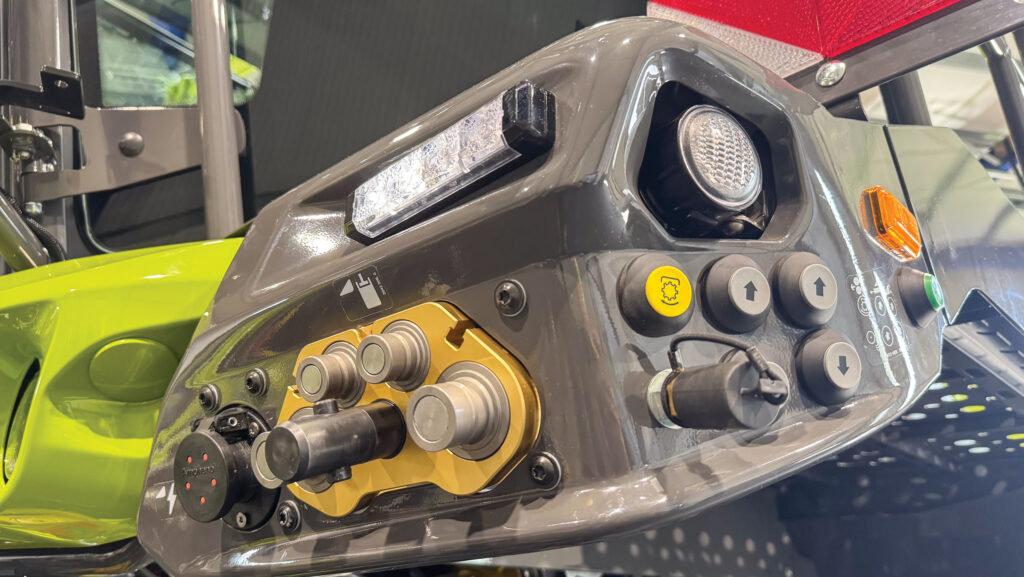
Attachment quick couplers © Adam Clarke
George’s verdict: “Shortening the maize chop for AD plants means slowing the header right down.
“A big advantage over the old header is that I no longer need to get out the cab to change speed on the gearbox, as it’s all done via the touchscreen and independent hydraulic drives.
“I’ve also got a ‘resume’ button, which I use in maize to save time at new fields.
“Before, I’d have to hold a button to unfold and set up the header and chute, but selecting ‘resume’ now returns it to my preferred settings.
“This gives me time to do other tasks, such as setting GPS A-B lines or readying the system to map a field.
“In work, the new header follows the ground better than the old Orbis.
“Previously, on ridges, the header fought to stay level as there was no middle sensor. That’s now fixed.
“There are also two land wheels either side, which hydraulically adjust themselves to keep the whole table stable.
“I don’t have to worry about breaking them if I suddenly need to go in reverse either, as the machine automatically lifts them out the way.”
Digital tools
- New Nutrimeter measures dry matter, starch, protein and sugar
- Data feeds into Claas Connect for analysis and sharing
- Auto chop-length adjustment and yield mapping
George’s verdict: “We had a dry matter sensor on the 980 but this new Nutrimeter gives us and our customers far more information.
“Daniel and I are both on the Claas Connect app and can share live data with the farms we’re working on.
“They can then decide how that’s used or what to do with poorer quality forage should it need separating from the best in the clamp.
“It’s straightforward as there is no calibration – all I need to do is select the crop type, and clean the sensor occasionally.
“The only thing I’m not a fan of tech-wise is the GPS screen, which is far more complicated to navigate than competitor systems.
“We run RTK on the forager and, as a contractor visiting different farms daily, easier use would help.”
Operator comfort
- Quieter cab, optional swivelling leather seat with heating/ventilation
- Joystick steering option with programmable buttons
- Improved ergonomics (foot pegs, higher cab and better visibility)
- More storage space
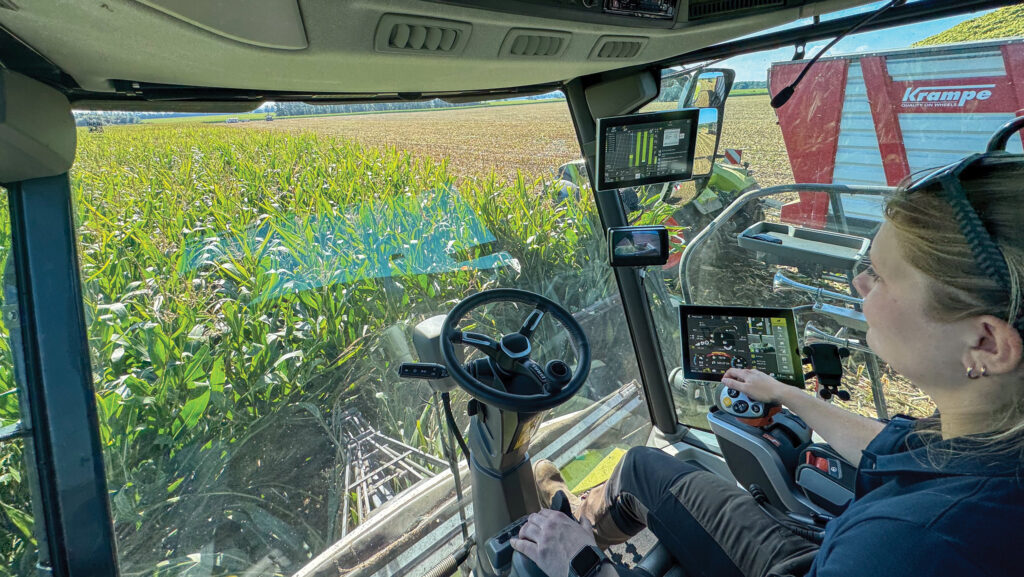
Claas Jaguar 1200 cab © Adam Clarke
George’s verdict: “I’d be upset if we had a forager without joystick control now.
“As soon as I get in the field, the steering wheel is up out of the way.
“The joystick has got six sensitivity settings and, when I first started using it, I had it on the least sensitive (1), which requires a lot of input to steer sharply.
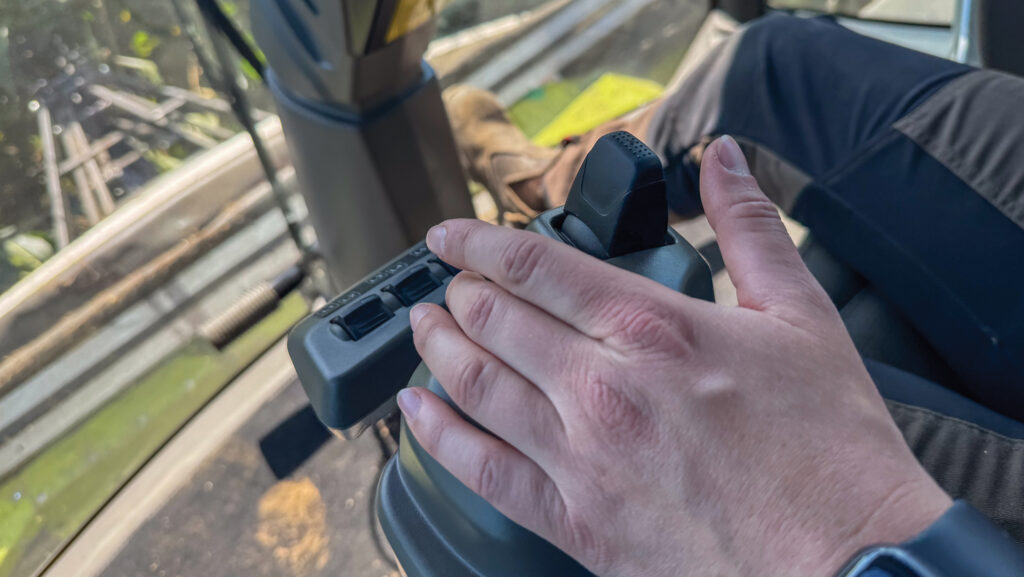
Joystick steering © Adam Clarke
“Now I’ve got used to it, it’s on setting 5 and I barely need to move it at all.
“And I can sit back with my feet on the new foot pegs, rather than being hunched over the steering wheel.
“This gives a more comfortable driving position and better view, which comes into its own with the wider maize header.
“The new swivel seat moves a long way and is useful in grass, as I tend to keep the spout on the right side.
“I don’t have to turn my head much to see the back of the trailer, and the cab is also a bit higher, so it all improves visibility to the spout.
“There’s also more space for all the things I need, so I haven’t got stuff stacked up on the passenger seat, which makes it a much nicer place to be.”

